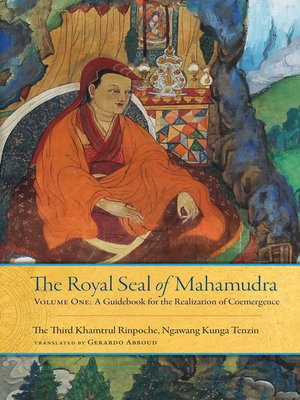The Royal Seal of Mahamudra, Volume 1
ebook ∣ A Guidebook for the Realization of Coemergence
By Rinpoche Khamtrul

Sign up to save your library
With an OverDrive account, you can save your favorite libraries for at-a-glance information about availability. Find out more about OverDrive accounts.
Find this title in Libby, the library reading app by OverDrive.



Search for a digital library with this title
Title found at these libraries:
| Library Name | Distance |
|---|---|
| Loading... |
This guidebook for cultivating the meditative practices of stability and insight—the first major work from the Drukpa Kagyu lineage to become available in English—stands out among works of its kind as one of the clearest and most comprehensive presentations of coemergence, or mahamudra. In it, the eighteenth-century Tibetan master Ngawang Kunga Tenzin, the Third Khamtrul Rinpoche, details a step-by-step program of spiritual exercises that bring the meditator directly to clear realization of the fully perfect, ever-present, nondual nature of mind.
Beginning with the close relationship between phenomena and mind and the immense benefits of meditating on the nature of mind, the Third Khamtrul Rinpoche offers careful instructions on the four yogas of mahamudra together with advice on how to recognize genuine progress and how to remove obstacles that arise during meditation. Characteristic of the Drukpa Kagyu approach is that, even from the earliest stages of training, the author explains how all experience, thoughts, and perceptions may be used as the path to enlightenment from the perspective of insight into the nature of mind.
Beginning with the close relationship between phenomena and mind and the immense benefits of meditating on the nature of mind, the Third Khamtrul Rinpoche offers careful instructions on the four yogas of mahamudra together with advice on how to recognize genuine progress and how to remove obstacles that arise during meditation. Characteristic of the Drukpa Kagyu approach is that, even from the earliest stages of training, the author explains how all experience, thoughts, and perceptions may be used as the path to enlightenment from the perspective of insight into the nature of mind.







